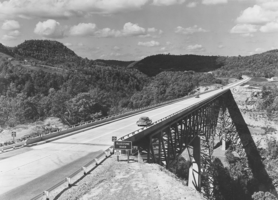 | Back to e-WV
| Back to e-WV
 The West Virginia Encyclopedia
The West Virginia Encyclopedia
 | Back to e-WV
| Back to e-WV
 The West Virginia Encyclopedia
The West Virginia Encyclopedia

The state’s only toll road originated in 1947 with the legislature’s creation of the West Virginia Turnpike Commission. The commission envisioned a four-lane highway from Charleston to Princeton to open the southern counties of the Mountain State. The route chosen varied only a few miles from a straight line between Charleston and Princeton. It was estimated the new road would cut the driving time in half, from four hours to two.
Following six years of planning, work on the West Virginia Turnpike began in 1952 and took less than two years to construct. But for the most part it was only two lanes, since prospective revenues were judged as too small to finance four lanes. Revenue bonds totaling $96 million were issued in April 1952 for the estimated $78 million project, with more bonds sold midway through construction when unexpected slides required correction at additional expense.
The commission held groundbreaking ceremonies August 29, 1952, in Mercer County and awarded the last contract for grading and bridge substructure in July 1953. Construction activity was intense, reaching a peak of one million cubic yards of earth moving per week.
With multiple ceremonies, the southern 35 miles of highway was opened in September 1954 to a first-day total of 4,000 cars by Governor William Casey Marland and Turnpike Commissioner (and former governor) Okey Patteson. When the final 51 miles between Charleston and Beckley was opened two months later, the total project had cost $133 million, averaging a nearly unheard of $1.5 million per mile. The Yeager Bridge (now southbound) and the Charlton Memorial Bridge (now southbound) are both noted as “Exceptionally Significant Features of the Federal Interstate Highway System” for engineering and transportation by the Federal Highway Administration.
With six miles of four lanes and 25 miles of third lanes for passing on long upgrades, the turnpike was modern for its day. As times changed, however, sections of the original concrete paving shifted, creating a ‘‘hump’’ between slabs, and motorists increasingly familiar with four-lane highways grew impatient with the turnpike. In 1958, the turnpike was included in the two-year-old interstate highway system, and major changes began when the Federal Highway Act of 1966 set interstate standards to require at least four lanes of traffic. After a consultant’s study concluded that upgrading the turnpike to carry Interstate 77 (and later Interstate 64 between Charleston and Beckley) would be less costly than building a new highway, the 1968 Federal Highway Act included a provision permitting the use of interstate funding for the reconstruction, while the 1970 act allowed tolls to be retained.
After a slow start, reconstruction began in earnest in December 1976, aided by more than $352 million in interstate highway discretionary funds. Involving more than one-third more earth moving than the original construction, at a cost of nearly $700 million, the four-lane upgrading of the turnpike was finished in September 1987. Symbolizing the 40-year effort, the final project was a huge open cut that replaced the obsolete Memorial Tunnel and an adjacent bridge by moving 10 million cubic yards of earth from a 371-foot-high cut in the mountain to a 311-foot-deep fill in the adjoining valley.
After much public debate, the legislature in 1989 authorized the issuance of new bonds, which meant the continuation of tolls on the turnpike. The same legislation replaced the old Turnpike Commission with the West Virginia Parkways, Economic Development and Tourism Authority. In 1996, the Authority opened Tamarack, a showcase for state artisans’ work, in Beckley. By its 50th anniversary, the West Virginia Turnpike had exceeded original predictions. Expected to carry more than two million vehicles in its first year and accommodating nearly five million in 1986, the last year before its entire distance became four lanes, today’s turnpike carries more than 12 million vehicles annually.
e-WV presents West Virginia Public Broadcasting on the West Virginia Turnpike
Written by Carol Melling